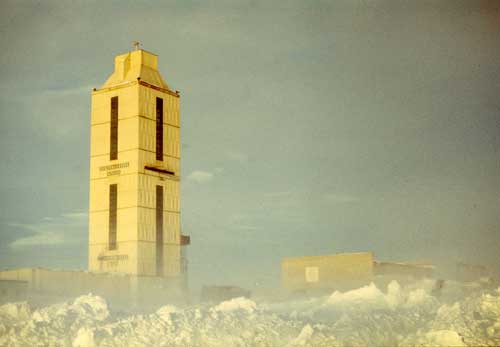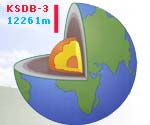1. Objectives The Kola Superdeep borehole (KSDB-3) provides a unique opportunity to set up a model that would adequately reflect the genuine Archean, Proterozoic and modern geodynamics, structure, composition and properties of crystalline substances quasi in situ down to a depth of 12,261 m, constituting the granitic-metamorphic layer of the EarthÆs crust in the Lower Precambrian part of the Baltic Shield.  The main tasks envisage determining such physical parameters as elasticity, elastic anisotropy under in situ conditions, micro-fracturing, permeability, porosity, viscosity etc. It is supposed to investigate relationships between seismic velocities and elasticity, elastic anisotropy, structure and changes in composition of rocks in situ. In conjunction with the lithologic column, penetrated by the KSDB-3, the experimentally determined data will be used to construct models for the velocity and density structure of the middle crust. The geological, mineralogical, geophysical and petrophysical data obtained in the four shafts of KSDB-3 will be used for 3-D structural modelling. The main tasks envisage determining such physical parameters as elasticity, elastic anisotropy under in situ conditions, micro-fracturing, permeability, porosity, viscosity etc. It is supposed to investigate relationships between seismic velocities and elasticity, elastic anisotropy, structure and changes in composition of rocks in situ. In conjunction with the lithologic column, penetrated by the KSDB-3, the experimentally determined data will be used to construct models for the velocity and density structure of the middle crust. The geological, mineralogical, geophysical and petrophysical data obtained in the four shafts of KSDB-3 will be used for 3-D structural modelling. It is planned to investigate the response of the water column in KSDB-3 to earth tidal (and possibly tectonic) forces, to barometric loading, to the passage of seismic wave fields. Geo-acoustic noise will be investigated along the KSDB-3 section. It is planned to provide data on the thermal history of the KSDB-3 section, partly on the basis of secondary minerals and their associations, to draw conclusion about the vertical variation of heat producing elements their mineralogy and mobility. Particular attention should be paid to setting models of geomechanical conditions, fields of modern and paleo-stresses in the borehole, to investigate their change from the surface to the deepest point of 12.261 km. An assessment of the current stresses (including tectonics) will be made by analysing core disking, borehole axis inclination and caverns orientations in the borehole shafts. These factors are applicable in research relating to deep-level nuclear waste disposal and repositories for long-term storage of such waste. 2. Background The Kola Superdeep Borehole (KSDB-3) reached a final depth of 12,261 m. It was drilled since the seventies in the framework of the programme ōInvestigation of the continental crust by means of deep drillingö of the former USSR. The main results of the technical experience, gained from this record deep drilling, of the investigation of the core and the geophysical logging were presented and discussed at several international congresses and conferences, including the 27th International Geological Congress held in Moscow (1984), and have been published in numerous papers and books. According to publications, the main borehole (and several complementary ones) intersected the entire sedimentary-volcanic sequence of the Lower Proterozoic Pechenga Formation (0-6,842 m) and a considerable part (6,842-12,261 m) of the Archean granitic-metamorphic complex of the basement (gneisses, amphibolites, migmatites and granitoids). The Archean complex has been studied more thoroughly in KSDB-3, than the Proterozoic part of the section. Certain technological difficulties of deep drilling had an advantageous side effect: several shafts were sunk (0-11.66, 9.32-12.07, 7.0-12.26 km and some others), which made it possible to perform stratigraphic subdivision, determine the conditions under which the main lithologies occur at different depth levels. Various deep-seismic investigations were performed in the recent years in, around and across the drill site area. These investigations involved such methods as deep seismic sounding (DSS), seismic exploration, common-depth point (CDP) and vertical seismic profiling (VSP) and acoustic logging. A KOLA-SD vibro-seismic profile has been run with the use of MEPTZ vibrators. Elastic properties of rocks in the Proterozoic section are generally subject to stratigraphy. In the Archean part of the section (6.84-12.26 km), the changes in rock elastic properties appear to be independent on geological features. This situation can result from the insufficient reliability of the geologic models used, and/or from a considerable influence of other physical factors affecting the elastic properties (such factors as anisotropy, fracturing, porosity and temperature). This is the reason for investigating the influence of these factors on elastic properties of rocks in situ. New results have been obtained from the study of physical properties of core samples. Leucocratic (gneiss, granite and migmatite) and melanocratic (amphibolite, schist and meta-gabbro) rocks of the Archean complex have distinctly different density values ( ), and the difference generally becomes more pronounced with depth. Longitudinal wave velocity (Vp) determinations in core samples indicated that these are even more depth-dependent, and this especially pertains to the leucocratic rocks. While near the surface Vp varies from 6.2 to 6.75 km/s, in the rocks extracted from the depth of 12 km Vp varies from 0.6 to 6.75 km/s. Acoustic logging and vertical seismic profiling showed that rocks at a depth of 10-12 km have average Vp = 6.2 km/s. The lower Vp values in the rocks extracted from great depths are a result of disintegration, which is a process of formation of numerous micro-fractures at the boundaries of anisotropic mineral grains. This phenomenon takes place when a core sample is lifted to the surface and the mineral grains are released from the compression stress, temperature and influence of bore hole liquids. To avoid this phenomenon one has to determine physical properties under the mid-crustal P¢T conditions. ), and the difference generally becomes more pronounced with depth. Longitudinal wave velocity (Vp) determinations in core samples indicated that these are even more depth-dependent, and this especially pertains to the leucocratic rocks. While near the surface Vp varies from 6.2 to 6.75 km/s, in the rocks extracted from the depth of 12 km Vp varies from 0.6 to 6.75 km/s. Acoustic logging and vertical seismic profiling showed that rocks at a depth of 10-12 km have average Vp = 6.2 km/s. The lower Vp values in the rocks extracted from great depths are a result of disintegration, which is a process of formation of numerous micro-fractures at the boundaries of anisotropic mineral grains. This phenomenon takes place when a core sample is lifted to the surface and the mineral grains are released from the compression stress, temperature and influence of bore hole liquids. To avoid this phenomenon one has to determine physical properties under the mid-crustal P¢T conditions. A study of elastic anisotropy of core samples along the KSDB-3 section by the acousto-polariscopy method has made it possible to subdivide the section into two distinctly different zones on the basis of the anisotropy index. One zone extends from the surface down to the depth of 4.43 km and consists of low-anisotropic and nearly isotropic rocks, such as meta-diabase, meta-peridotite, meta-phyllite, meta-tuff, meta-sandstone, and meta-siltstone. This zone contains copper¢nickel mineralization at a depth interval of 1.8-1.9 km, accompanied by high anisotropy. A sharp boundary going along the Luchlompolo fault is recorded at a depth of 4.43 km. The strong elastic anisotropy is situated within the interval of 4.43 to 8.3 km, and then it is monotonously decreasing. But anisotropy, measured in lab conditions, does not correspond to that, measured in situ. Despite the obvious achievements of the studies described above, the previous research plan did not provide sufficient scope for investigation of some physical properties, such as elasticity, elastic anisotropy under in situ conditions. Combining the acousto-polariscopy method with simultaneous measurements of longitudinal and shear wave splitting in three orthogonal directions of the cube shaped samples in simulated in situ conditions is considered to provide powerful tools for investigation of the nature of seismic anisotropy. This approach allows to separate the crack-related anisotropy from the texture-related anisotropy and to estimate the importance of micro-structural and textural characteristics for the in situ properties, in addition to the bulk composition of the rock. The conditions of fluid and thermal regimes in KSDB-3 have not been fully studied by the previous investigators. The response of the water column in the KSDB-3 and adjacent boreholes to earth tidal (and possibly tectonic) forces, to barometric loading gives an evidence of the role of pore fluids, their transport and stress transfer in the middle crust. Geo-acoustic noise logging will be an additional method for investigating the influence of the above-mentioned reasons. The Kola Superdeep provides a unique possibility to study the vertical variation of heat-producing elements, as well as their mineralogy and mobility in the 12,261m deep section. Geomechanical conditions, fields of modern and paleo-stresses in the borehole, their change from the surface to the deepest point of 12.261 km are insufficiently investigated. The study of secondary minerals and their associations in veins, cracks, fissures and fault zones give reliable background information for the development and arrangement of paleo-fluids and paleo-fluid systems. The results give essential marginal notes on late ancient thermal and barometric regimes as a basis for the derivation of paleo-stresses and the paleo-dynamic reconstruction in the Proterozoic and Archean sections. It is required to assess the current stresses by analysing core disking, borehole axis inclination, caverns orientation in the borehole shafts and conduct mathematical and physical modelling. The multi-disciplinary investigations will allow models to be constructed for velocity and density structure, thermal regime, paleo- and modern stresses, and the geomechanical conditions in the middle crust. One of these will be a model of real P-T conditions down to a depth of 12,261 m. The geological, geophysical and petrophysical data obtained in four shafts will be used for structural 3-D modelling and reconstructing geodynamics in the KSDB-3 section. The proposed project partly corresponds to the tasks of the UNESCO IGCP-408 Project ōRocks and minerals at Great Depth and on the Surfaceö (this Project does not provide financial support for the investigations). The aim of the proposed project gives a good motivation and permits to obtain better results for both projects. The approval of the project can bring outstanding scientific results in the social sphere as well (geomechanical stability of the continental crust, potentials and risks for waste disposal at depth et al.) |



